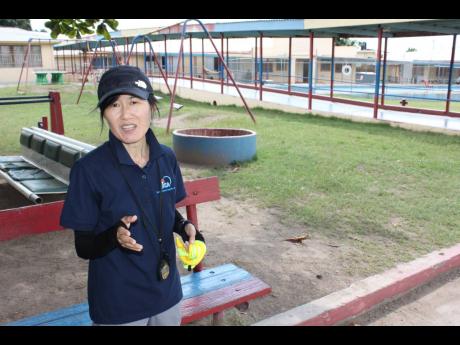On your marks, get set, go…
If one were to meet Yoko Yamada, her demeanor and persona would come across as someone who’s a very soft spoken, subtle, and gentle. Every bit of the Japanese gentleness – but then looks can be deceiving isn’t it?
She is a task master in the field.
“Come on, you can do it. Focus! Focus!” were the instructions from Yamada, which were followed by several shrill whistle sounds, enough to the put the students in their get-set-and-go mode. A regular day at the school grounds and a physical education (PE) class in progress, only that some of the students are running along a string laid down in a straight line in pairs.
Yamada, a Japan International Cooperation Agency (JICA) volunteer at the Salvation Army School for the Blind and Visually Impaired in St Andrew, is raising the bar and helping the students to find self-confidence.
Her approach is simple: never give up!
“Some students are afraid of challenges and trying new things,” Yamada said, adding that some of them would come to her and say, “Me can’t.”
“I don’t want to hear that from our students,” she said. “It doesn’t matter whether they can or they cannot, but they have to keep on trying.”
Overcoming challenges
Yamada, who worked for over 10 years in a school for the blind in Japan, understands the challenges and is trying to help the students overcome them.
“They don’t have an image,” she said. “That image has to be created in word to help them understand and visualise the scenario and make an image in their brains.”
PE, she said, is one of the key tools that can help students who are blind and visually impaired to strengthen physically and mentally, in analysing situations, and to focus.
“This does not happen overnight,” Yamada said. “It takes time and patience, and we have to push the students to first overcome their mental blocks.”
Principal Iyeke Erharouyi agrees.
“Yoko has taught us how to be patient,” he said. “She has a good degree of patience. …I would say an overdose of patience.”
Patience, overall, is one the key traits of the Japanese people – What one might perceive as an overdose is the norm for them.
“I am thankful to Yoko for bringing about a change,” said Collen Dobson, business administration teacher at the school, who doubles up as the PE teacher.
“This kind of intervention was needed,” Dobson said, adding that it is not only students, but also teachers who are learning from the knowledge that Yamada is imparting.
LONG-DISTANCE RUNNING
“The students are learning life skills,” she said. “And it is gratifying for me to work with Yoko.”
Yamada is currently preparing the students for middle-and long-distance running, Grade 8 student Nicola Anderson is training to participate in the Kingston City Run. “I am training them in endurance and stamina,” Yamada said.
A guide bow is the key. A piece of plastic rope, it is clasped by the runner who is visually impaired on one end. Hi or her guide runner holds the other end of the rope, and both run or jog in unison.
“Nicola is doing very well,” Yamada said. “She is a champion.”
Yamada also has taken upon herself to be the guide runner for Anderson. She jogs and runs along at the same time, encouraging then to push themselves, look beyond their physical challenges, and to do more.
The definition of who is ‘normal’ and who is not needs to be changed.
Strengthen the mind
“It is not only the body, but the mind that needs to be strengthened to overcome challenges and at the same time believe in themselves,” Yamada said.
“So,” she said, “I started challenging the students to participate in running events. They were reluctant at first, but they are gaining confidence each day.”
Yamada understands the limitations, too, and is trying her best to let the students see the whole picture.
She cites the story of the five blind men and the elephant, which originated from the Indian subcontinent. There were once four blind men who came across an elephant, and each of them was touched one part of the elephant’s body – leg, tail, trunk, ears – and formed their opinion of what the elephant looked like. From hairy to cylindrical to flappy – they were all right, but did not get the whole picture and disagreed with each other.
The ‘blindness’ in the case of this story is a metaphor – we might be right in our own way, but the skewed visions, we grossly overlook the bigger picture.
“I am trying to see how best I can show them (the students) the elephant in its totality,” Yamada said.
Meanwhile on the grassy field, she is encouraging the students to put more stamina and pace into their running.
“Run straight, run straight,” Yamada said to the students. “Very good, you are doing well.”
Indeed, they are doing very well, and with proper training, guidance, and encouragement, they are going to go places.

